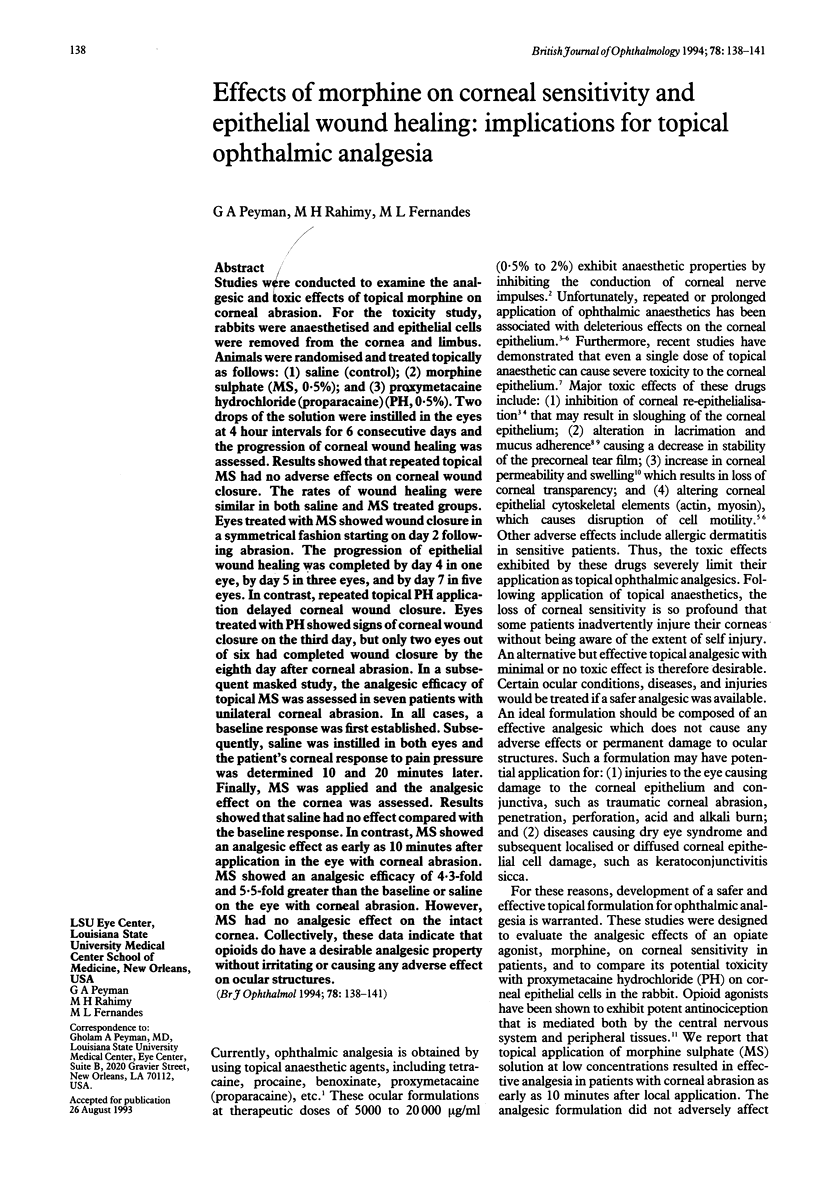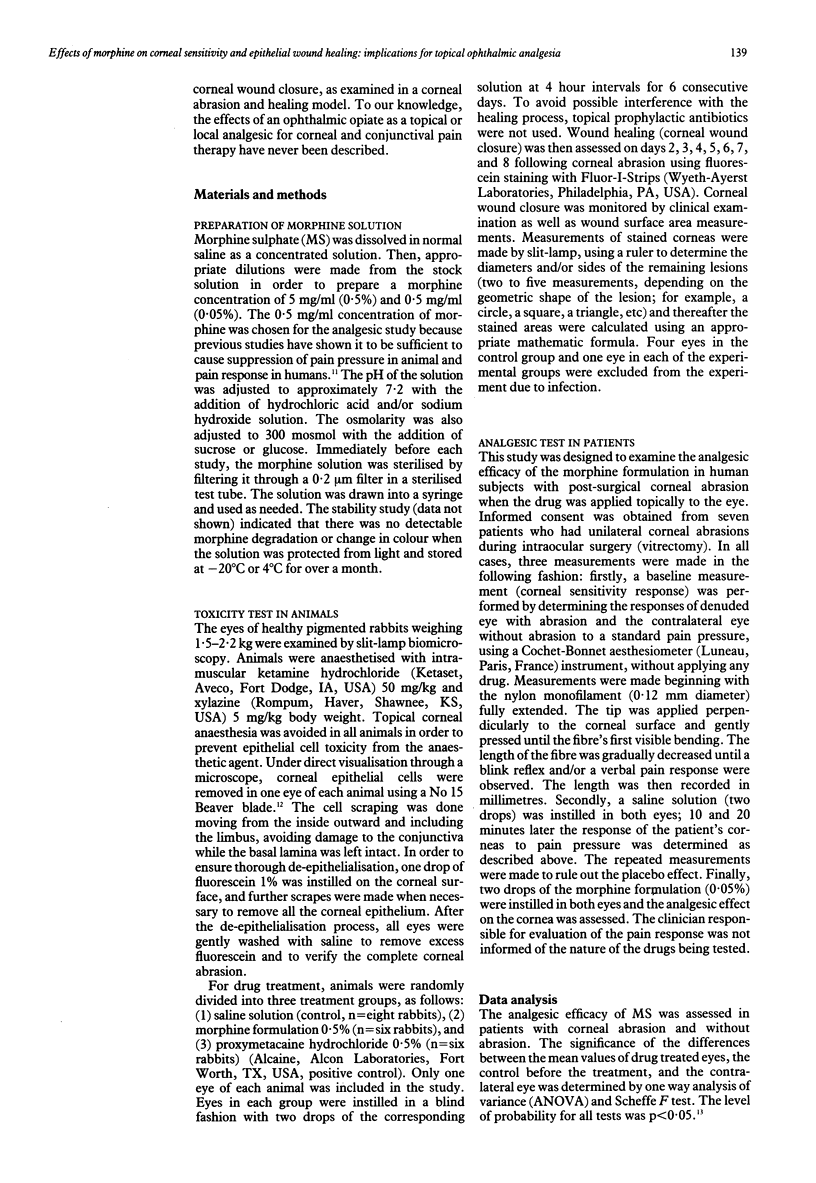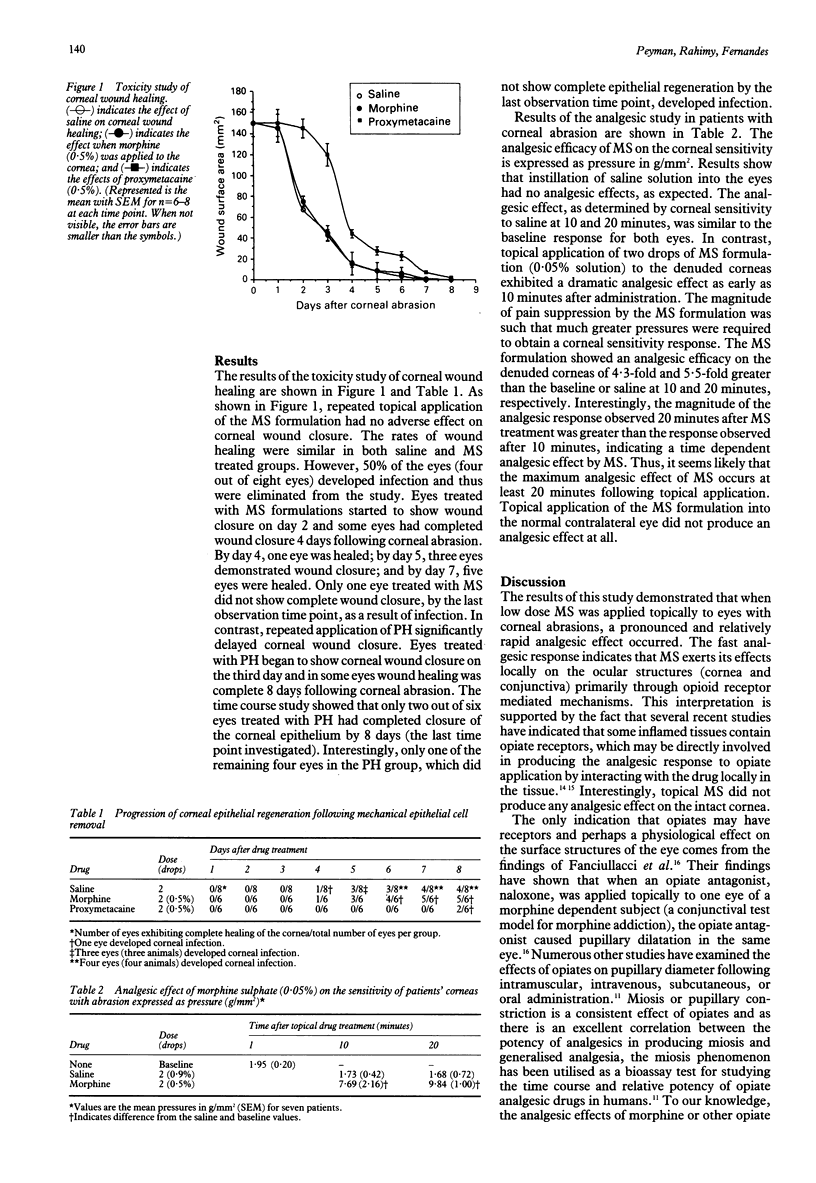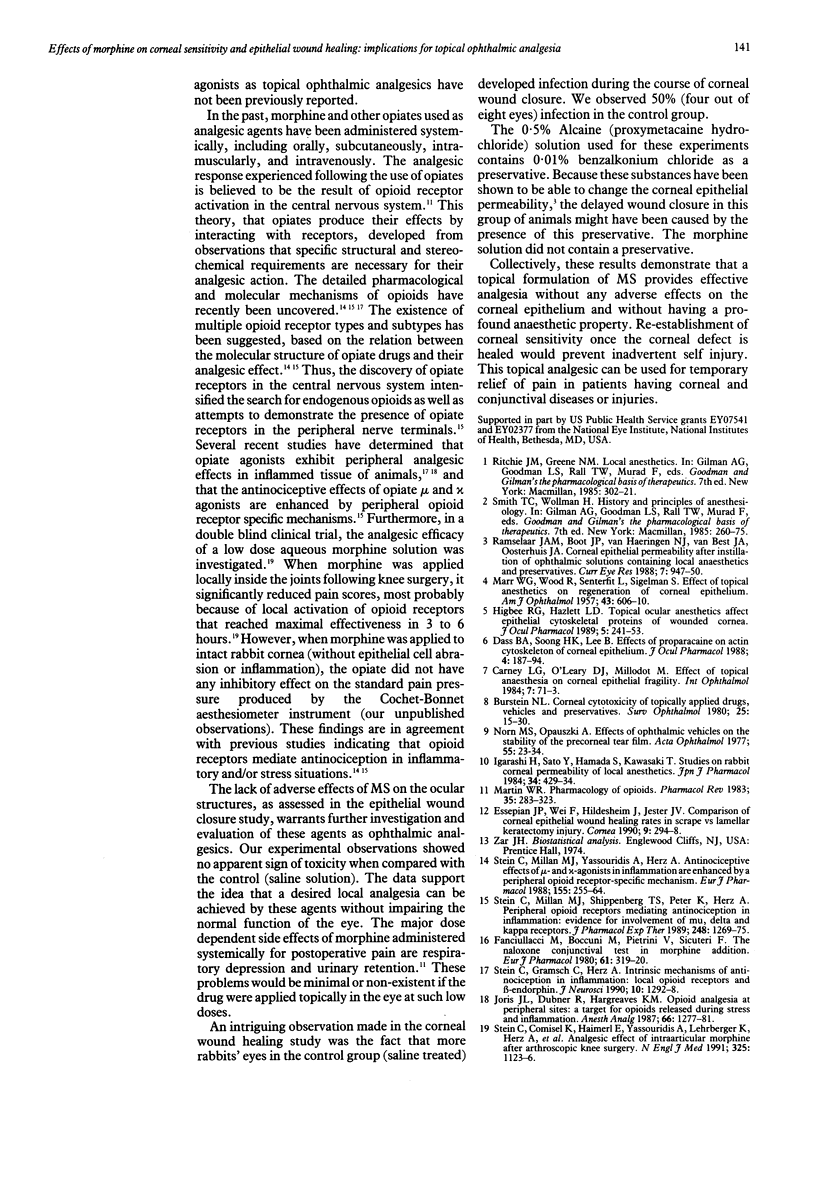Abstract
Studies were conducted to examine the analgesic and toxic effects of topical morphine on corneal abrasion. For the toxicity study, rabbits were anaesthetized and epithelial cells were removed from the cornea and limbus. Animals were randomised and treated topically as follows: (1) saline (control); (2) morphine sulphate (MS, 0.5%); and (3) proxymetacaine hydrochloride (proparacaine) (PH, 0.5%). Two drops of the solution were instilled in the eyes at 4 hour intervals for 6 consecutive days and the progression of corneal wound healing was assessed. Results showed that repeated topical MS had no adverse effects on corneal wound closure. The rates of wound healing were similar in both saline and MS treated groups. Eyes treated with MS showed wound closure in a symmetrical fashion starting on day 2 following abrasion. The progression of epithelial wound healing was completed by day 4 in one eye, by day 5 in three eyes, and by day 7 in five eyes. In contrast, repeated topical PH application delayed corneal wound closure. Eyes treated with PH showed signs of corneal wound closure on the third day, but only two eyes out of six had completed wound closure by the eighth day after corneal abrasion. In a subsequent masked study, the analgesic efficacy of topical MS was assessed in seven patients with unilateral corneal abrasion. In all cases, a baseline response was first established. Subsequently, saline was instilled in both eyes and the patient's corneal response to pain pressure was determined 10 and 20 minutes later. Finally, MS was applied and the analgesic effect on the cornea was assessed. Results showed that saline had no effect compared with the baseline response. In contrast, MS showed an analgesic effect as early as 10 minutes after application in the eye with corneal abrasion. MS showed an analgesic efficacy of 4.3-fold and 5.5-fold greater than the baseline or saline on the eye with corneal abrasion. However, MS had no analgesic effect on the intact corneal. Collectively, these data indicate that opioids do have a desirable analgesic property with out irritating or causing any adverse effect on ocular structures.
Full text
PDF



Selected References
These references are in PubMed. This may not be the complete list of references from this article.
- Burstein N. L. Corneal cytotoxicity of topically applied drugs, vehicles and preservatives. Surv Ophthalmol. 1980 Jul-Aug;25(1):15–30. doi: 10.1016/0039-6257(80)90072-7. [DOI] [PubMed] [Google Scholar]
- Carney L. G., O'Leary D. J., Millodot M. Effect of topical anaesthesia on corneal epithelial fragility. Int Ophthalmol. 1984 Jun;7(2):71–73. doi: 10.1007/BF00165107. [DOI] [PubMed] [Google Scholar]
- Dass B. A., Soong H. K., Lee B. Effects of proparacaine on actin cytoskeleton of corneal epithelium. J Ocul Pharmacol. 1988 Fall;4(3):187–194. doi: 10.1089/jop.1988.4.187. [DOI] [PubMed] [Google Scholar]
- Essepian J. P., Wei F., Hildesheim J., Jester J. V. Comparison of corneal epithelial wound healing rates in scrape vs. lamellar keratectomy injury. Cornea. 1990 Oct;9(4):294–298. [PubMed] [Google Scholar]
- Fanciullacci M., Boccuni M., Pietrini U., Sicuteri F. The naloxone conjunctival test in morphine addiction. Eur J Pharmacol. 1980 Feb 8;61(3):319–320. doi: 10.1016/0014-2999(80)90136-3. [DOI] [PubMed] [Google Scholar]
- Higbee R. G., Hazlett L. D. Topical ocular anesthetics affect epithelial cytoskeletal proteins of wounded cornea. J Ocul Pharmacol. 1989 Fall;5(3):241–253. doi: 10.1089/jop.1989.5.241. [DOI] [PubMed] [Google Scholar]
- Igarashi H., Sato Y., Hamada S., Kawasaki T. Studies on rabbit corneal permeability of local anesthetics (I). Jpn J Pharmacol. 1984 Apr;34(4):429–434. doi: 10.1254/jjp.34.429. [DOI] [PubMed] [Google Scholar]
- Joris J. L., Dubner R., Hargreaves K. M. Opioid analgesia at peripheral sites: a target for opioids released during stress and inflammation? Anesth Analg. 1987 Dec;66(12):1277–1281. [PubMed] [Google Scholar]
- MARR W. G., WOOD R., SENTERFIT L., SIGELMAN S. Effect of topical anesthetics on regeneration of corneal epithelium. Am J Ophthalmol. 1957 Apr;43(4 Pt 1):606–610. [PubMed] [Google Scholar]
- Martin W. R. Pharmacology of opioids. Pharmacol Rev. 1983 Dec;35(4):283–323. [PubMed] [Google Scholar]
- Norn M. S., Opauszki A. Effects of ophthalmic vehicles on the stability of the precorneal film. Acta Ophthalmol (Copenh) 1977 Feb;55(1):23–34. doi: 10.1111/j.1755-3768.1977.tb06092.x. [DOI] [PubMed] [Google Scholar]
- Ramselaar J. A., Boot J. P., van Haeringen N. J., van Best J. A., Oosterhuis J. A. Corneal epithelial permeability after instillation of ophthalmic solutions containing local anaesthetics and preservatives. Curr Eye Res. 1988 Sep;7(9):947–950. doi: 10.3109/02713688808997251. [DOI] [PubMed] [Google Scholar]
- Stein C., Comisel K., Haimerl E., Yassouridis A., Lehrberger K., Herz A., Peter K. Analgesic effect of intraarticular morphine after arthroscopic knee surgery. N Engl J Med. 1991 Oct 17;325(16):1123–1126. doi: 10.1056/NEJM199110173251602. [DOI] [PubMed] [Google Scholar]
- Stein C., Gramsch C., Herz A. Intrinsic mechanisms of antinociception in inflammation: local opioid receptors and beta-endorphin. J Neurosci. 1990 Apr;10(4):1292–1298. doi: 10.1523/JNEUROSCI.10-04-01292.1990. [DOI] [PMC free article] [PubMed] [Google Scholar]
- Stein C., Millan M. J., Shippenberg T. S., Peter K., Herz A. Peripheral opioid receptors mediating antinociception in inflammation. Evidence for involvement of mu, delta and kappa receptors. J Pharmacol Exp Ther. 1989 Mar;248(3):1269–1275. [PubMed] [Google Scholar]
- Stein C., Millan M. J., Yassouridis A., Herz A. Antinociceptive effects of mu- and kappa-agonists in inflammation are enhanced by a peripheral opioid receptor-specific mechanism. Eur J Pharmacol. 1988 Oct 18;155(3):255–264. doi: 10.1016/0014-2999(88)90511-0. [DOI] [PubMed] [Google Scholar]


